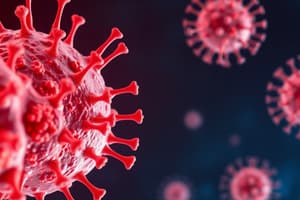Podcast
Questions and Answers
Which type of hypersensitivity reaction is primarily mediated by sensitized mast cells?
Which type of hypersensitivity reaction is primarily mediated by sensitized mast cells?
- Type I (correct)
- Type III
- Type II
- Type IV
Type II hypersensitivity reactions always result in the lysis of target cells.
Type II hypersensitivity reactions always result in the lysis of target cells.
True (A)
What is the primary antibody involved in Type III hypersensitivity reactions?
What is the primary antibody involved in Type III hypersensitivity reactions?
IgG
The release of chemicals like histamine, kinin, and prostaglandins is characteristic of Type ______ hypersensitivity reactions.
The release of chemicals like histamine, kinin, and prostaglandins is characteristic of Type ______ hypersensitivity reactions.
Match the type of hypersensitivity reaction with its corresponding mechanism of tissue injury:
Match the type of hypersensitivity reaction with its corresponding mechanism of tissue injury:
Which of the following is an example of a Type I hypersensitivity reaction?
Which of the following is an example of a Type I hypersensitivity reaction?
Type III hypersensitivity reactions occur immediately after exposure to an antigen.
Type III hypersensitivity reactions occur immediately after exposure to an antigen.
What is the main mechanism of tissue injury in Type II hypersensitivity reactions?
What is the main mechanism of tissue injury in Type II hypersensitivity reactions?
In type II hypersensitivity, cell lysis can be mediated by (IgM or IgG) activated complement fragments or by ______ cells.
In type II hypersensitivity, cell lysis can be mediated by (IgM or IgG) activated complement fragments or by ______ cells.
Which of the following conditions is associated with Type III hypersensitivity?
Which of the following conditions is associated with Type III hypersensitivity?
Flashcards
Type I Hypersensitivity
Type I Hypersensitivity
An immediate allergic reaction mediated by sensitized mast cells and IgE.
IgE Antibodies
IgE Antibodies
Immunoglobulin E; antibodies that bind to allergens and trigger mast cell degranulation.
Mast Cell Degranulation
Mast Cell Degranulation
Release of chemicals like histamine from mast cells leading to allergy symptoms.
Type II Hypersensitivity
Type II Hypersensitivity
Signup and view all the flashcards
Complement Activation
Complement Activation
Signup and view all the flashcards
Type III Hypersensitivity
Type III Hypersensitivity
Signup and view all the flashcards
Antigen-Antibody Complexes
Antigen-Antibody Complexes
Signup and view all the flashcards
Chronic Infections
Chronic Infections
Signup and view all the flashcards
Examples of Type I
Examples of Type I
Signup and view all the flashcards
Examples of Type III
Examples of Type III
Signup and view all the flashcards
Study Notes
Hypersensitivity Disorders
- Hypersensitivity reactions are immune responses that cause tissue damage. These reactions can be of various types, differing in immune cell involvement and mechanisms.
- Type I hypersensitivity (anaphylactic) involves a rapid response, mediated by IgE antibodies and mast cells.
- Mast cells release histamine, kinins, prostaglandins, leukotrienes, leading to vasodilation, increased permeability, urticaria, bronchoconstriction. This response can occur within 15-30 minutes.
- Examples include drug reactions, rhinitis, atopic eczema, bee sting reactions, and asthma.
Type II Hypersensitivity
- Type II hypersensitivity (cytotoxic) involves antibodies (IgM or IgG) binding to antigens on cell surfaces.
- This can lead to cell lysis through complement activation or phagocytosis.
- This reaction happens within 15-30 minutes.
- Examples include transfusion reactions, erythroblastosis fetalis, myasthenia gravis, and hyperacute graft rejection.
Type III Hypersensitivity
- Type III hypersensitivity (immune complex) involves antigen-antibody complexes deposited in tissues.
- This activates the complement cascade and attracts phagocytic cells, causing inflammation and tissue damage.
- This reaction occurs within 6 hours.
- Examples include glomerulonephritis, systemic lupus erythematosus (SLE), farmer's lung, and vasculitis.
Type IV Hypersensitivity
- Type IV hypersensitivity (delayed-type) is T cell-mediated, not antibody-mediated.
- Sensitized T cells react with altered or foreign cells, causing inflammation in the dermal regions.
- This reaction occurs within 24-48 hours.
- Examples include contact dermatitis, tuberculin reactions, transplant rejection, graft-versus-host disease, Guillain-Barré syndrome, and multiple sclerosis.
Hypersensitivity Reactions Conclusion
- Type I: IgE-mediated; quick onset after exposure.
- Type II: IgG/IgM mediated; Cytotoxic.
- Type III: Immune complex deposition; various inflammatory reactions.
- Type IV: Delayed or cell-mediated; T cells mediate the inflammatory reaction.
Studying That Suits You
Use AI to generate personalized quizzes and flashcards to suit your learning preferences.




